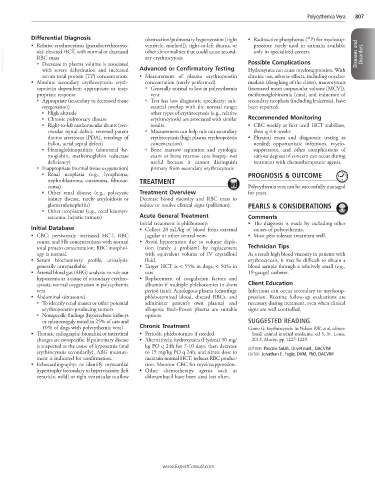Page 1603 - Cote clinical veterinary advisor dogs and cats 4th
P. 1603
Polycythemia Vera 807
Differential Diagnosis obstruction/pulmonary hypertension [right • Radioactive phosphorus ( P) for myelosup-
32
• Relative erythrocytosis (pseudoerythrocyto- ventricle, marked]), right-to-left shunts, or pression: rarely used in animals; available
VetBooks.ir RBC mass Advanced or Confirmatory Testing Possible Complications Diseases and Disorders
other abnormalities that could cause second-
sis): elevated HCT, with normal or decreased
only in specialized centers
ary erythrocytosis
○ Decrease in plasma volume is associated
with severe dehydration and increased
chronic use, adverse effects, including onycho-
serum total protein (TP) concentration. • Measurement of plasma erythropoietin Hydroxyurea can cause myelosuppression. With
• Absolute secondary erythrocytosis: eryth- concentration (rarely performed) madesis (sloughing of the claws), macrocytosis
ropoietin dependent; appropriate or inap- ○ Generally normal to low in polycythemia (increased mean corpuscular volume [MCV]),
propriate response vera methemoglobinemia (cats), and induction of
○ Appropriate (secondary to decreased tissue ○ Test has low diagnostic specificity; sub- secondary neoplasia (including leukemia), have
oxygenation) stantial overlap with the normal range; been reported.
High altitude other types of erythrocytosis (e.g., relative
■
Chronic pulmonary disease erythrocytosis) are associated with similar Recommended Monitoring
■
Right-to-left cardiovascular shunts (ven- results. • CBC weekly at first until HCT stabilizes,
■
tricular septal defect, reversed patent ○ Measurement can help rule out secondary then q 4-6 weeks
ductus arteriosus [PDA], tetralogy of erythrocytosis (high plasma erythropoietin • Physical exam and diagnostic testing as
Fallot, atrial septal defect) concentration). needed; opportunistic infections, myelo-
Hemoglobinopathies (abnormal he- ○ Bone marrow aspiration and cytologic suppression, and other complications of
■
moglobin, methemoglobin reductase exam or bone marrow core biopsy: not various degrees of concern can occur during
deficiency) useful because it cannot distinguish treatment with chemotherapeutic agents.
○ Inappropriate (normal tissue oxygenation) primary from secondary erythrocytosis
Renal neoplasia (e.g., lymphoma,
■ PROGNOSIS & OUTCOME
nephroblastoma, carcinoma, fibrosar- TREATMENT
coma) Polycythemia vera can be successfully managed
Other renal disease (e.g., polycystic Treatment Overview for years.
■
kidney disease, rarely amyloidosis or Decrease blood viscosity and RBC mass to
glomerulonephritis) reduce or resolve clinical signs (palliation). PEARLS & CONSIDERATIONS
Other neoplasms (e.g., cecal leiomyo-
■
sarcoma, hepatic tumors) Acute General Treatment Comments
Initial treatment is phlebotomy: • The diagnosis is made by excluding other
Initial Database • Collect 20 mL/kg of blood from external causes of polycythemia.
• CBC: persistently increased HCT, RBC jugular or other central vein. • Most pets tolerate treatment well.
count, and Hb concentrations with normal • Avoid hypotension due to volume deple-
total protein concentration; RBC morphol- tion (rarely a problem) by replacement Technician Tips
ogy is normal. with equivalent volume of IV crystalloid As a result high blood viscosity in patients with
• Serum biochemistry profile, urinalysis: fluid. erythrocytosis, it may be difficult to obtain a
generally unremarkable • Target HCT is < 55% in dogs, < 50% in blood sample through a relatively small (e.g.,
• Arterial blood gas (ABG) analysis: to rule out cats 19-gauge) catheter.
hypoxemia as a cause of secondary erythro- • Replacement of coagulation factors and
cytosis; normal oxygenation in polycythemia albumin if multiple phlebotomies in short Client Education
vera period (rare). Autologous plasma (centrifuge Infections can occur secondary to myelosup-
• Abdominal ultrasound phlebotomized blood, discard RBCs, and pression. Routine follow-up evaluations are
○ To identify renal masses or other potential administer patient’s own plasma) and necessary during treatment, even when clinical
erythropoietin-producing tumors allogenic fresh-frozen plasma are suitable signs are well controlled.
○ Nonspecific findings (hyperechoic kidneys options.
or splenomegaly noted in 25% of cats and SUGGESTED READING
10% of dogs with polycythemia vera) Chronic Treatment Couto G: Erythrocytosis. In Nelson RW, et al, editors:
• Thoracic radiographs: bronchial or interstitial • Periodic phlebotomies if needed Small animal internal medicine, ed 5, St. Louis,
changes are nonspecific. If pulmonary disease • Alternatively, hydroxyurea (Hydrea) 30 mg/ 2013, Mosby, pp 1227-1229.
is suspected as the cause of hypoxemia (and kg PO q 24h for 7-10 days, then decrease AUTHOR: Pascale Salah, Dr.vet.med., DACVIM
erythrocytosis secondarily), ABG measure- to 15 mg/kg PO q 24h, and titrate dose to EDITOR: Jonathan E. Fogle, DVM, PhD, DACVIM
ment is indicated for confirmation. maintain normal HCT; reduces RBC produc-
• Echocardiography: to identify myocardial tion. Monitor CBC for myelosuppression.
hypertrophy (secondary to hyperviscosity [left • Other chemotherapy agents such as
ventricle, mild] or right ventricular outflow chlorambucil have been used less often.
www.ExpertConsult.com

